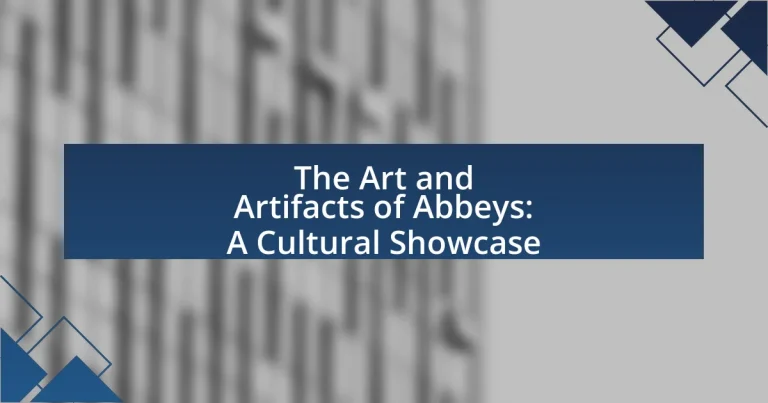The article focuses on abbeys, which are religious buildings serving as residences for monks or nuns, and their cultural significance. It explores how abbeys reflect historical and cultural contexts through their architectural styles, such as Gothic and Romanesque, and their role in local economies and education. The article also examines the various forms of art and artifacts found in abbeys, including illuminated manuscripts, sculptures, and liturgical items, highlighting their importance in preserving cultural heritage. Additionally, it discusses contemporary preservation efforts, challenges faced by abbeys, and ways for visitors to engage with and appreciate the art and artifacts housed within these significant cultural institutions.

What are Abbeys and Their Cultural Significance?
Abbeys are religious buildings that serve as residences for monks or nuns, typically associated with the Christian faith. They are significant cultural centers that have historically contributed to art, architecture, and education. For instance, many abbeys, such as Westminster Abbey in London, are renowned for their Gothic architecture and have hosted important events, including royal ceremonies and burials. Additionally, abbeys often house valuable artifacts, manuscripts, and artworks that reflect the spiritual and cultural heritage of their communities, thus playing a crucial role in preserving history and fostering cultural identity.
How do Abbeys reflect historical and cultural contexts?
Abbeys reflect historical and cultural contexts through their architecture, art, and the monastic practices they embody. The design of abbeys often incorporates elements from the prevailing architectural styles of their time, such as Romanesque or Gothic, which signifies the technological and aesthetic values of those periods. For instance, the use of pointed arches and ribbed vaults in Gothic abbeys illustrates advancements in engineering and a shift towards verticality and light, reflecting the cultural emphasis on spirituality and the divine.
Additionally, abbeys serve as repositories of art and artifacts that represent the socio-political and religious dynamics of their eras. The illuminated manuscripts produced in abbeys during the Middle Ages, such as the Book of Kells, showcase not only religious themes but also the cultural influences of the time, including Celtic art and iconography. Furthermore, abbeys often played pivotal roles in local economies and education, reflecting the interconnectedness of faith, culture, and community life throughout history. Thus, abbeys are not merely religious structures; they are vital historical documents that encapsulate the cultural narratives of their time.
What architectural styles are prevalent in Abbeys?
Gothic, Romanesque, and Baroque are the prevalent architectural styles in abbeys. Gothic architecture is characterized by pointed arches, ribbed vaults, and flying buttresses, which can be seen in structures like the Abbey of Saint-Denis in France. Romanesque architecture features thick walls, rounded arches, and sturdy pillars, exemplified by the Abbey of Cluny in France. Baroque architecture, known for its grandeur and elaborate details, is represented in abbeys such as the Abbey of Melk in Austria. These styles reflect the historical and cultural significance of abbeys throughout different periods.
How have Abbeys influenced local cultures and communities?
Abbeys have significantly influenced local cultures and communities by serving as centers of education, agriculture, and art. Historically, abbeys were not only places of worship but also hubs for learning, where monks transcribed texts and preserved knowledge, thus shaping the intellectual landscape of their regions. For example, the Abbey of Cluny in France, established in the 10th century, became a model for monastic reform and education, impacting numerous communities across Europe. Additionally, abbeys often engaged in agricultural innovations, introducing new farming techniques that improved local economies. The art produced within abbeys, including illuminated manuscripts and architecture, has left a lasting cultural legacy, as seen in the Gothic cathedrals that evolved from monastic designs. These contributions have fostered a sense of identity and continuity within local communities, reinforcing the abbeys’ role as pivotal cultural institutions.
What role do Abbeys play in religious practices?
Abbys serve as centers for communal worship, spiritual reflection, and monastic life within religious practices. They provide a structured environment where monks or nuns engage in prayer, meditation, and the observance of religious rituals, often following a specific rule, such as that of St. Benedict. Historically, abbeys have been instrumental in preserving religious texts, art, and music, contributing to the cultural and spiritual heritage of their communities. For example, the Abbey of Cluny in France, founded in 910, became a model for monastic reform and significantly influenced the development of liturgical practices across Europe.
How do Abbeys serve as centers for spiritual life?
Abbys serve as centers for spiritual life by providing a dedicated space for worship, contemplation, and community among individuals seeking spiritual growth. These religious institutions often host daily prayers, liturgical services, and retreats, fostering an environment conducive to deepening one’s faith. Historical evidence shows that many abbeys, such as the Abbey of Cluny in France, played pivotal roles in the monastic reform movement, emphasizing the importance of communal worship and spiritual discipline. Additionally, abbeys often house relics, sacred art, and manuscripts that enhance the spiritual experience, making them vital hubs for both individual and communal spirituality.
What rituals and traditions are associated with Abbeys?
Abbeys are associated with various rituals and traditions, primarily centered around monastic life and religious observance. These include the Liturgy of the Hours, which involves communal prayer at specific times throughout the day, and the celebration of the Eucharist, a central sacrament in Christian worship. Additionally, abbeys often host seasonal festivals, such as Advent and Lent, which involve specific liturgical practices and community gatherings. Historical records indicate that many abbeys also engage in the tradition of hospitality, welcoming pilgrims and travelers, which reflects their role as centers of spiritual and communal life in medieval Europe.

What Types of Art and Artifacts are Found in Abbeys?
Abbeys typically house a variety of art and artifacts, including illuminated manuscripts, religious paintings, sculptures, and architectural elements. Illuminated manuscripts, such as the Book of Kells, showcase intricate designs and calligraphy, reflecting the monastic dedication to preserving knowledge. Religious paintings often depict biblical scenes and saints, serving both decorative and didactic purposes. Sculptures, ranging from stone carvings to woodwork, frequently illustrate religious themes and figures. Architectural elements, including stained glass windows and altarpieces, enhance the spiritual atmosphere of abbeys while demonstrating the craftsmanship of the period. These artifacts collectively represent the cultural and historical significance of abbeys in preserving artistic heritage.
What are the most common forms of art in Abbeys?
The most common forms of art in Abbeys include stained glass windows, illuminated manuscripts, frescoes, and sculptures. Stained glass windows often depict biblical scenes and saints, serving both decorative and educational purposes. Illuminated manuscripts, created by monks, feature intricate designs and calligraphy, showcasing the artistry of the period. Frescoes adorn the walls of many Abbeys, illustrating religious narratives and enhancing the spiritual atmosphere. Sculptures, often found in cloisters and entrances, depict figures from Christian theology, contributing to the overall aesthetic and religious significance of the Abbeys.
How do paintings and frescoes contribute to the Abbey’s atmosphere?
Paintings and frescoes significantly enhance the Abbey’s atmosphere by infusing it with spiritual symbolism and historical context. These artworks often depict religious themes, which create a sense of reverence and contemplation, essential for a place of worship. For instance, frescoes illustrating biblical scenes can evoke emotional responses and deepen the spiritual experience for visitors. Additionally, the vibrant colors and intricate details of these artworks contribute to the visual richness of the space, making it more inviting and inspiring. Historical records indicate that many abbeys commissioned renowned artists to create these works, further establishing their importance in reflecting the cultural and artistic heritage of the period.
What significance do sculptures hold in Abbeys?
Sculptures in abbeys serve as vital expressions of religious devotion and artistic heritage. They often depict biblical figures, saints, and scenes that convey spiritual narratives, enhancing the worship experience for the monastic community and visitors. Historically, these sculptures have also functioned as didactic tools, educating the faithful about religious stories and moral lessons, particularly during periods when literacy was low. For instance, the intricate carvings found in the Abbey of Cluny in France illustrate the significance of sculpture in conveying theological concepts and community values during the medieval period.
What artifacts are typically preserved in Abbeys?
Abbeys typically preserve artifacts such as manuscripts, religious texts, liturgical items, artwork, and architectural elements. Manuscripts, often created by monks, include illuminated texts and historical documents that provide insight into the cultural and religious practices of the time. Liturgical items, such as chalices, vestments, and altar pieces, are essential for worship and reflect the craftsmanship of the period. Artwork, including frescoes and sculptures, often depicts biblical scenes and saints, serving both decorative and didactic purposes. Architectural elements, such as stone carvings and stained glass windows, contribute to the aesthetic and spiritual atmosphere of the abbey, showcasing the artistic styles prevalent during their construction. These artifacts collectively represent the historical, religious, and cultural significance of abbeys throughout history.
How do manuscripts and texts reflect the history of Abbeys?
Manuscripts and texts reflect the history of Abbeys by documenting their religious practices, daily life, and socio-political influences. These written records often include liturgical texts, chronicles, and correspondence that provide insights into the abbey’s role within the broader community and its interactions with secular authorities. For example, the “Book of Kells,” an illuminated manuscript created in a Celtic monastery, showcases the artistic and theological developments of its time, illustrating the abbey’s significance in preserving Christian teachings and culture. Additionally, abbey archives often contain records of land ownership and donations, which highlight the economic power and influence of these institutions throughout history.
What role do liturgical items play in Abbey life?
Liturgical items play a central role in Abbey life by facilitating worship and enhancing the spiritual experience of the monastic community. These items, such as chalices, vestments, and altar linens, are integral to the celebration of the Eucharist and other religious ceremonies, reflecting the Abbey’s commitment to tradition and reverence. The use of specific liturgical items is often rooted in historical practices, with many items being handcrafted or passed down through generations, thus embodying the Abbey’s cultural heritage and artistic expression. For example, the ornate chalices used during Mass not only serve a functional purpose but also symbolize the sacredness of the ritual, reinforcing the community’s faith and devotion.

How are Abbeys Preserved and Celebrated Today?
Abbys are preserved and celebrated today through a combination of restoration efforts, cultural events, and educational programs. Restoration projects often involve architectural conservation techniques to maintain the structural integrity and historical significance of abbeys, with organizations like English Heritage and the National Trust actively participating in these efforts. Cultural events, such as music festivals, art exhibitions, and religious ceremonies, are frequently held at abbeys, drawing visitors and fostering community engagement. Educational programs, including guided tours and workshops, aim to inform the public about the historical and cultural importance of abbeys, ensuring their legacy is appreciated by future generations.
What conservation efforts are in place for Abbeys and their artifacts?
Conservation efforts for Abbeys and their artifacts include restoration projects, climate control measures, and educational programs. Restoration projects aim to preserve the structural integrity and historical significance of Abbeys, often involving skilled artisans and conservation specialists who use traditional techniques. Climate control measures are implemented to protect artifacts from environmental damage, ensuring stable temperature and humidity levels to prevent deterioration. Educational programs engage the public and promote awareness of the importance of preserving these cultural sites, often supported by organizations such as UNESCO, which recognizes the value of Abbeys as part of the world’s heritage.
How do modern technologies aid in the preservation of Abbey art?
Modern technologies aid in the preservation of Abbey art through advanced imaging techniques, climate control systems, and digital archiving. High-resolution imaging, such as 3D scanning and infrared reflectography, allows for detailed documentation and analysis of artworks, revealing underlying layers and previous restorations. Climate control systems maintain optimal temperature and humidity levels, preventing deterioration caused by environmental factors. Additionally, digital archiving enables the creation of virtual collections, making Abbey art accessible for research and education while reducing the need for physical handling, which can cause wear. These technologies collectively enhance the longevity and accessibility of Abbey art, ensuring its preservation for future generations.
What challenges do Abbeys face in terms of preservation?
Abbeys face significant challenges in terms of preservation, primarily due to environmental factors, funding limitations, and structural deterioration. Environmental factors such as moisture, pollution, and climate change can accelerate the decay of building materials and artifacts. Funding limitations often hinder restoration efforts, as many abbeys rely on donations and grants, which may not be sufficient to cover extensive preservation needs. Structural deterioration is a critical issue, as aging buildings require ongoing maintenance to prevent collapse and loss of historical integrity. For instance, the English Heritage report highlights that many abbeys are at risk due to inadequate resources for necessary repairs and conservation efforts.
How can visitors engage with Abbey art and artifacts?
Visitors can engage with Abbey art and artifacts through guided tours, interactive exhibits, and educational workshops. Guided tours provide in-depth knowledge about the historical significance and artistic value of the artifacts, often led by knowledgeable staff or historians. Interactive exhibits allow visitors to experience the art in a hands-on manner, enhancing their understanding and appreciation. Educational workshops offer opportunities for visitors to create their own art inspired by the Abbey’s collections, fostering a personal connection to the cultural heritage. These engagement methods are designed to enrich the visitor experience and promote a deeper understanding of the Abbey’s artistic contributions.
What are the best practices for appreciating Abbey art during visits?
To appreciate Abbey art during visits, engage in focused observation and contextual understanding. Visitors should take time to examine the details of the artwork, noting elements such as style, color, and technique, which can reveal the historical and cultural significance of the pieces. Additionally, learning about the history of the Abbey and the artists involved enhances appreciation; for instance, many Abbeys feature art that reflects the religious and social contexts of their time, such as Gothic architecture or Renaissance paintings. Guided tours often provide valuable insights, making them a recommended practice for deeper understanding.
How do guided tours enhance the understanding of Abbey artifacts?
Guided tours enhance the understanding of Abbey artifacts by providing expert insights and contextual information that deepen visitors’ appreciation. These tours often include knowledgeable guides who explain the historical significance, artistic techniques, and cultural relevance of the artifacts, allowing visitors to grasp the nuances that might be overlooked during self-guided exploration. For instance, a guided tour may highlight the craftsmanship of a medieval manuscript, detailing the materials used and the historical context of its creation, which enriches the visitor’s experience and understanding of the artifact’s importance within the Abbey’s heritage.





